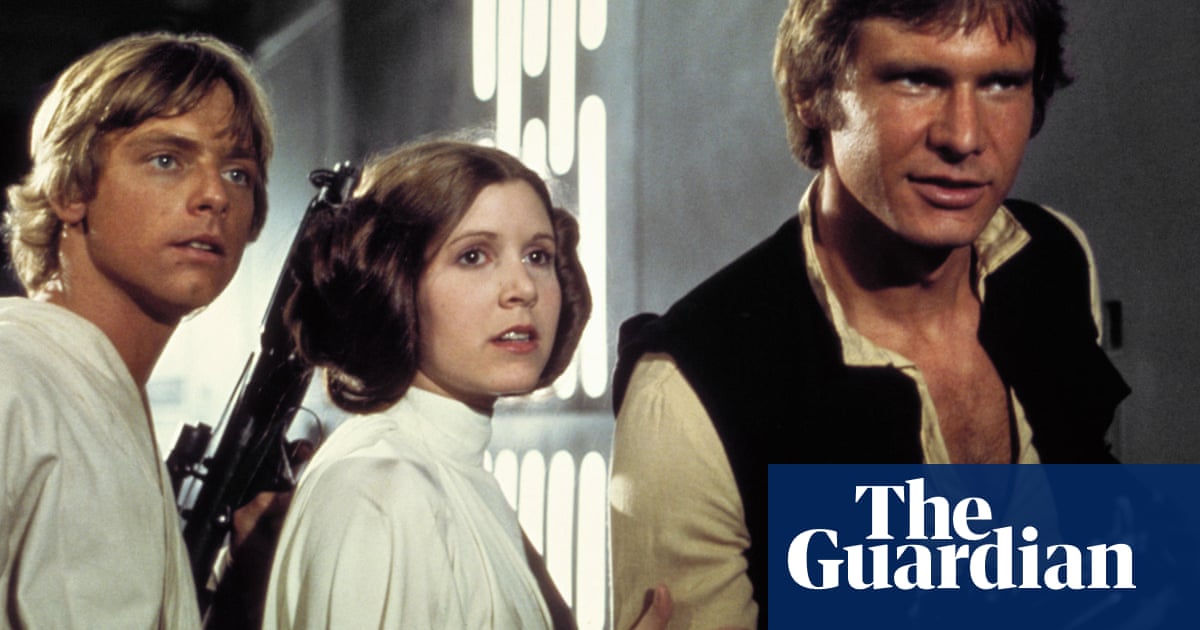Arelatively long time ago in cinemas near and far away, the first Star Wars film captivated a generation of children and adults. As the British Film Institute in London this weekscreens the original 1977 theatrical version of the space opera, which has rarely been shown since the 1990s, readers have shared their recollections of its groundbreaking special effects, iconic heroes and villains, and queueing around the block for tickets.
Most of those who responded to a Guardian callout recalled being mesmerised by the film’sopening crawl, then “blown away” by the first scene in whichPrincess Leia’s starship is captured by an immense Imperial Star Destroyer. “It loomed right over our heads in the theatre, immediately putting us in the action, alerting us to the huge stakes in this world,” said Marilyn Stacey, a 68-year-old paralegal and actor from Portland, Oregon, who saw the film with her boyfriend in Westwood, Los Angeles, soon after it opened in the US in May 1977.
Many readers saidStar Warswas the first “grownup” film they saw as children, with their few previous trips to the cinema being for Disney films such as Mary Poppins or the Herbie comedies about a sentient Volkswagen Beetle.
Mark Hannaby, who was six in 1978 when his father drove him from the suburbs of Wrexham, north-east Wales, to see the film at the biggest screen nearby at the Odeon in Liverpool, recalled how it captured his imagination. “At that age, I don’t think you expect the external world to correspond with your internal world,” said Hannaby, 52, now a journalism lecturer at the University of Chester. “Dad said my face never left the screen. I was hungry for the story, and unusually uninterested in the wine gums he offered. Even for years afterwards, nothing really compared to it.”
Lois Pass, from Southend-on-Sea, who didn’t have a TV at home when she saw the film as a teenager in 1978, agreed. “To suddenly see battles taking place in space, travel faster than the speed of light, plus this mysterious power – the Force – in a galactic battle between good and evil was simply mind-blowing,” she said.
Like many readers, Cliff Ramshaw’s anticipation for the film had been fuelled by its merchandising. By the time it came out in the UK, Ramshaw, now 58, had already read the novelisation and part of the Marvel comic book adaptation, and had decorated his school haversack with drawings of X-wings and Tie fighters. Unfortunately, his father did not share his enthusiasm for the film when he took him and his younger brother to see it in Sunderland in 1978.
“We arrived early and Dad, not wanting to hang around, took us in straight away [to an earlier screening],” he recalled. “We sat down just in time to seethe attack on the Death Star. After the movie ended we remained seated while the audience left and a new crowd arrived. We saw the beginning and middle of the movie and then, when the attack on the Death Star was about to start, Dad took us out of the cinema and drove us home!”
Ramshaw, who now lives in the Cotswolds, didn’t get to see the film the whole way through until it was aired on British TV four years later. But his unusual viewing experience did not dampen his love for Star Wars, and he later became a software engineer at George Lucas’s visual effects companyIndustrial Light & Magic.
Luke Skywalker’s journey froma farm boy on a backwater planetto a hero of the rebellion particularly enraptured readers who had grown up in small or remote communities. Back in 1978, Pass, who grew up in the Essex coastal town of Shoeburyness, was grappling with discomfort about her “lowly position on the social scale” at the local grammar school. “There was Luke, a poor, scruffy, nobody from nowhere, just like me, suddenly plucked from obscurity to discover his true calling. Obi-Wan Kenobi revealing that there is a whole lot more to his life than he could ever have imagined [was] a potent message!”
Many women who responded to the callout recalled how enamoured they were with Princess Leia’s attitude. Rebecca Pollock, a HR worker from Brisbane, Australia, said: “For a young girl, growing up in a country town in Queensland, watching an amazing heroine like Princess Leia dominate her world gave me a role model who was brave, adventurous and strong in the face of adversity. I loved it when she looked up at Darth Vader and talked back to him, and her banter with Han Solo. Her wit and sarcastic approach was so different to what I’d seen women be.”
It wasn’t just children and teenagers who were enraptured. Milton Justice, a former artistic director of theStella Adler Academy of Acting and Theatre, saw the film afterCarrie Fisher, who played Princess Leia, auditioned for a part in a murder-mystery film he was producing.
“I remember Carrie’s audition, because she was very quirky as an actor. She didn’t get the part. After Star Wars opened, I went back into the company and said: ‘Are you guys crazy?’ I later knew her socially. She really was one of the funniest people ever. Even some of the line readings she did in Star Wars had that kind of way that she saw life.”
Justice, who now runsa podcast about acting, said back then many people in the movie industry thought Star Wars was just a one-off. “In an odd sense, we might have been more respectful of the story than the special effects. I don’t blame Star Wars for the fact that so many movies today have so many special effects that you don’t even see the story. I think it’s very separate from those kind of films.”
